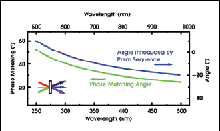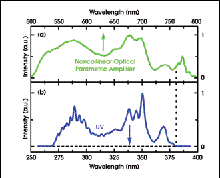
Tunable Femtosecond UV Pulses Produced by Second-Harmonic Generation
Breck Hitz
The measurement of extremely fast physical and chemical phenomena requires femtosecond pulses such as those generated in the infrared by Ti:sapphire lasers. However, ultrafast experiments with many materials require tunable femtosecond pulses in the ultraviolet, and such pulses cannot be readily generated.
Recently, researchers at Ludwig Maximilians Universität in Munich, Germany, generated what they believe are the shortest tunable ultraviolet pulses yet reported. They compressed and frequency-doubled the broadband visible pulses from a Ti:sapphire-pumped noncollinear optical parametric amplifier (NOPA) to obtain 7.1-fs pulses tunable between 275 and 335 nm.
To frequency-double the visible pulses, the scientists employed "achromatic" second-harmonic generation (SHG), a process that was proposed in the 1970s but that has not been heavily explored. It's a variation of angle-tuned SHG.
In angle-tuned SHG, the propagation angle in the birefringent, nonlinear crystal is adjusted until the extraordinary refractive index matches the constant, ordinary refractive index. Then the fundamental light, in the ordinary polarization, propagates in phase with the extraordinary second harmonic, and efficient SHG can occur.
Because the crystal is dispersive, the exact phase-matching angle depends on the fundamental wavelength. If the fundamental is very broadband, there is no single angle that phase-matches the entire bandwidth. In achromatic SHG, the broadband fundamental is angularly dispersed so that each wavelength component propagates at the correct angle for phase-matched SHG.

Figure 1. In achromatic second-harmonic generation, a broadband fundamental signal is separated into its frequency components so that each component can propagate through the nonlinear crystal at its own phase-matching angle.
The concept is illustrated in Figure 1. The first prism separates the high-frequency components (yellow-green) of the incoming beam from the low-frequency components (red-orange). The frequency components are collimated with a second prism, and they subsequently are focused into the nonlinear crystal. The different frequency components pass through the crystal at different angles. On the other side of the crystal, the second-harmonic frequency components recombine into a collimated output beam. The green line in Figure 2 shows the phase-matching angle as a function of wavelength in beta-barium borate (BBO). The blue line is the angular dispersion of the experimental arrangement, which was similar to Figure 1. Clearly, if the crystal is oriented at the appropriate angle, the two curves will overlap and achromatic SHG can take place.

Figure 2. The green curve is the calculated phase-matching angle in BBO, and the blue curve is the angular dispersion of an experimental arrangement similar to Figure 1.
In a traditional prism pulse compressor (Figure 3), the incoming pulse must be chirped, with the low-frequency components ahead of the high-frequency ones. The low-frequency components (red line) follow a slower path through the compressor (because they travel through more glass), so that by the time they emerge, the high-frequency components have caught up with them, and the output pulse is shorter than the incoming one.

Figure 3. In a prism pulse compressor, the low-frequency components (red line) take a slower path because they travel through more glass, and they catch up with the high-frequency components.
A comparison of Figures 1 and 3 reveals that the Munich arrangement is, in effect, a prism pulse compressor with a frequency doubler in the middle. With an arrangement conceptually similar to Figure 1, the researchers generated 250 nJ per pulse of ultraviolet light with a second-harmonic efficiency of ~20 percent at the nonlinear crystal. (The experimental arrangement included a deformable mirror not shown in Figure 1 to adjust the chirp of the ultraviolet pulse.)
The achromatic phase-matching technique increased the effective bandwidth of the BBO crystal by a factor of 80. The broadband input pulses from the NOPA covered most of the visible spectrum (Figure 4a), and the bandwidth of the ultraviolet output pulses stretched from 275 to 375 nm (Figure 4b). The Fourier limit of the ultraviolet pulses was 2.9 fs.

Figure 4. The input pulses to the frequency doubler/pulse compressor spanned the visible spectrum (a), and the output pulses preserved almost the entire spectral width of the input (b). The sharp cutoff at the long-wavelength end of the ultraviolet spectrum resulted from a physical obstruction in the experimental arrangement.
To generate ultrafast, tunable pulses, the researchers reduced the bandwidth of the incoming pulses from the NOPA and tuned them within the visible spectrum. The resulting output pulses, whose measured pulse duration was as short as 7.1 fs, were tunable from 275 to 335 nm.
Published: September 2004